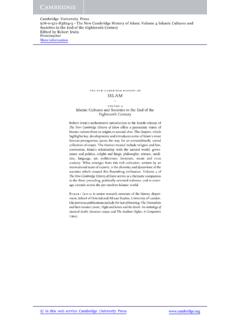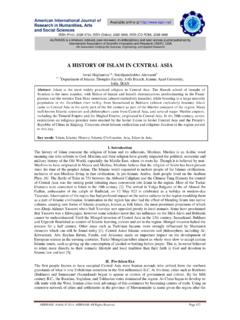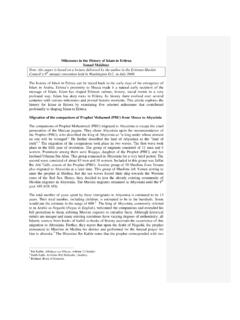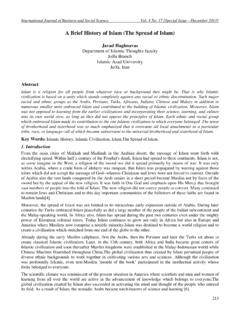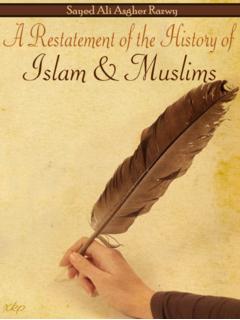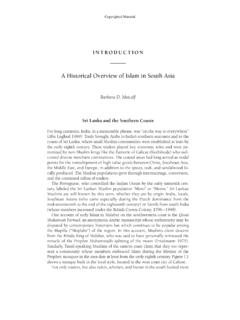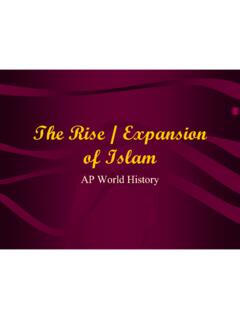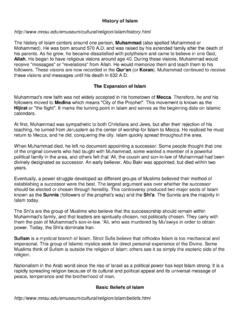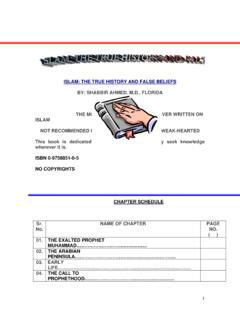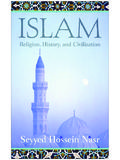Transcription of Archaeology and the History of Early Islam: The First ...
1 Archaeology AND THE History OF Early islam : THE First seventy YEARSBYJEREMY JOHNS*AbstractThe rarity of material evidence for the religion of islam during the rst seventy years ofthe hijra (622-92 CE) has been used to attack the traditional positivist account of the rise ofIslam. However, the earliest declarations of islam are to be found on media produced by theearly Islamic state. It is therefore mistake to read too much signi cance into the absence ofsuch declarations prior to the formation of that state by Abd al-Malik (685-705 CE). Thereis little prospect that Archaeology will uncover new evidence of islam from the rst manque de donn es mat rielles sur la religion de l islam pendant les sept premi resd cennies de l h gire (622-92) a t utilis pour r futer la th orie positiviste traditionelle del essor de l islam .
2 Cependant, les premi res d clarations de l islam sont trouver dans desoeuvres produites par l Etat islamique ses d buts. Il est donc erron d attribuer trop de sens l absence de telles d clarations avant la formation de cet Etat par Abd al-Malik (685-705).Il y a peu de perspectives de nouvelles d couvertes arch ologiques sur l islam des sept pre-mi res d : Epigraphy, Numismatics, Papyri, Religion, State FormationIn 1991, Judith Koren and the late Yehuda Nevo issued a methodologi-cal challenge to historians of Early islam . They were encouraged to do so bytheir reading of the so-called revisionist historians, including Patricia Crone,Michael Cook, Gerald Hawting, Moshe Sharon, and John Wansbrough, whosework, Koren and Nevo believed, had completely undermined the foundationsupon which the traditional positivist account of the rise of islam had been con-structed.
3 None of the written Islamic sources for the rst two hundred years ofthe hijra could be used as evidence for what had actually happened. Archaeol-ogy, which in any case consisted of objective facts that were always to be pre-ferred over subjective written sources, was therefore almost the only evidenceavailable, and should be used to compose a new account of the origins of islam Koninklijke Brill NV, Leiden, 2003 JESHO46,4 Also available online * Jeremy Johns, The Oriental Institute, University of Oxford, Pusey Lane, OxfordOX1 2LE, JOHNS that would be radically different from the traditional historical narrative. The polem-ical style permitted historians to dismiss this article as not worth an answer,while Nevo s unorthodox interpretation of material evidence embarrassedarchaeologists into silence (Fig.)
4 1).1 What, it was widely asked, could have per-suaded Der Islamto waste space in this manner?The editor, the late Albrecht Noth, was himself one of the radical , as much as any, was keenly aware of the problematic character of theIslamic literary has rarely been described more judiciously andsuccinctly than by Stephen Humphreys (1991: 69-70):If our goal is to comprehend the way in which Muslims of the late 2nd/8th and 3rd/9thcenturies understood the origins of their society, then we are very well of f indeed. Butif our aim is to nd out what really happened , to develop reliably documentedanswers to modern questions about the earliest decades of Islamic societies then weare in Arabic narrative sources represent a rather late crystallisation of a uid oral tra-dition.
5 These sources can become an adequate foundation for scienti c History onlywhen we have learned a great deal more than we presently know about this oral tradi-tion: its origins, the social and cultural institutions by which it was shaped and trans-mitted, the variations and transformations it underwent in the course of transmission, thecircumstances in which it was rst committed to writing, the degree of alteration suf-fered by Early written versions before they at last achieved their de nitive form in themid-3rd/9th century, etc. Questions of this kind have been discussed over and over bymodern scholars, but so far their conclusions remain more in the realm of speculationthan of demonstration.
6 The evidence is such, in fact, that reasonable certainty may bebeyond our grasp.. The rst seventy years of Islamic History command our attention, therefore, notonly because of the enormous interest of this period, but also because of the extraordi-nary methodological problems posed by our principal sources for , a pioneer of new methodological approaches to the Islamic literarysources, was attracted by the methodological terms of the challenge issued byKoren and Nevo, and believed that Der Islamshould give archaeologists a chance to air their views (personal communication). A similar respect for1 See also Nevo and Koren (1990: 23-44), Nevo (1994; 1993; 1991).
7 For a critique seeFoss (1995: 231-33). The publication of Nevo s Crossroads to Islamwas halted by his deathin February 1992, but it was published in June 2003 by Prometheus Books, Amherst, NewYork, ISBN 1591020832. This essay was already in press before it appeared. Unlike hisinterpretation of the excavations at Sde Boqer, Nevo s epigraphic studies demand to be rst part of his Habilitationsschrift, Quellenkritische Studien zu Themen, Formen undTendenzen fr hislamischer Geschichts berlieferung, I. Themen und Formenwas published bythe Department of Oriental Studies in the University of Bonn in 1973, and was read and citedwith approval by Cook, Crone, Hawting, and Wansborough.
8 Although the second part, onTendenzen, was never published, a revised English edition subsequently appeared as Noth andConrad (1994).3 For an up-to-date and wide-ranging introduction to the controversy, see Berg (2003). Archaeology AND THE History OF Early ISLAM413 Figure 1: Ground plan of eighth-century (?) domestic structures from Area J at SdeBoqer (Naqab); the inset shows an elevation of a doorway (after Nevo 1990: gs 3 &7b). Nevo interpreted such structures as part of a pagan sanctuary, analogous to theMeccan aram; each structure (for Nevo, a ijr cf. Mecca) contained shards of ceram-ics and glass, grinding stones, animal bones, ash, etc.
9 , ordinary domestic refuse,which Nevo interpreted as ritually deposited fragments or a m(cf. Mecca), while heidenti ed the jambs of the doorways as an b or JOHNS Archaeology as a sovereign discipline that is not the mere slave of historyclearly informs the initiative by JESHOto which this essay is a contribution(Yoffee 2002).Koren and Nevo were not the rst to turn to Archaeology for evidence in sup-port of a radical reinterpretation of the rise of islam . For example, in Hagarism,Crone and Cook (1977: 3) had explored the possibility that one way around thehistoriographical problem posed by the Islamic sources was to step outside theIslamic tradition altogether and start again.
10 Although their account of the for-mation of islam as a religion was based for the most part upon non-Islamicwritten sources, they occasionally cited archaeological evidence in corroborationof it. For example, the proposition that the original sanctuary of the primitiveMuslims (muh jir n) was not Mecca but Bakka (Qur n ), an unidenti edsite in north-western Arabia well to the north of Medina, was dramaticallycon rmed by the eccentric orientation (qibla) of the mosques excavated atW si (Fig. 2) and Usk f Ban Junayd (both in Iraq).4 Hagarismis perhaps nowbest regarded as a highly entertaining and provocative thought-experimentwhich, with a certain recklessness to use the authors own words, attemptedextensive reconstruction at a time when the task of deconstruction was stillunderway.
